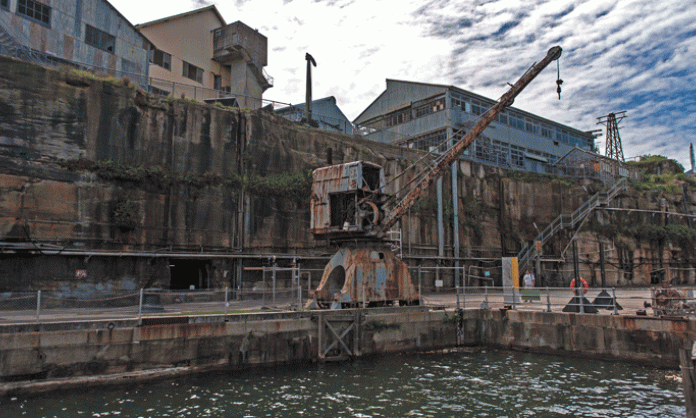The ACTU delivered the news. “That’s it, it’s finished”, Bill Kelty told Cockatoo Island Dockyard workers. It was 1987. The Hawke Labor government was closing them down. The 2,000 who worked there were done.
“It was a fait accompli”, says Claude Sandaljian, who was a boilermaker on the island at the time. The company contracted to run the dockyard was Australian National Industries. Come 1992, they were told, the federal government would not renew ANI’s lease. The land would be sold.
The island
Off the shores of Balmain, Cockatoo Island (Wareamah) – the largest of the islands dotting Sydney Harbour – was Australia’s primary shipbuilding facility. Its biggest graving dock, Sutherland, was for a time the largest dry dock in the world.
Claude worked at Cockatoo from 1974. It was a highly disputatious workplace. “It was a hot shop”, he says. “It was a very politicised place from the beginning.”
Boilermakers were always among the most militant. They had to be, because they were usually the first to go when there were retrenchments. “It took me five years to become a delegate [of the AMWU] – there was a lot of struggle at the [union] meetings.”
In 1987 Claude was elected chairman of the island’s combined shop committee. With delegates from the 13 unions in the dockyard, the shop committee represented all manual workers on the island.
He explains how it worked: “The shop committee met if there was something that affected all unions or if a union was in trouble and wanted the support of the rest of the unions or it’s something to do with wages that involved everybody. Of course the question of closure involved everybody.”
‘You’re finished’
Under the threat of shutdown, the committee decided it was time to ask for severance money. This was a first for workers on the Island. “We never had severance money or nothing in those days … We were against severance money, because accepting it is accepting that your job is gone”, Claude explains.
In shipbuilding, as in manufacturing generally at the time, retrenchments were common. At Cockatoo the idea was always to get the jobs back.
“When there was a retrenchment, say 40 or 60 boilermakers, straight away no more overtime was worked. ‛You don’t need overtime, you’ve been retrenching people!’ ‛The books are closed? You don’t employ anybody?’ Well, straight away there’s no overtime. That’s us [the boilermakers] and the painters and dockers that did that.”
On Cockatoo Island, workers looked out for each other. People worked their whole lives making money for the bosses yet often ended up with little to show for it, except for injuries and worn-out bodies. While the bosses sought to throw them on the scrap heap and bring in younger bodies to grind, the workers had different ideas.
“When they opened the books again, the priority was rehiring the people who’d been retrenched, even if they were useless to the boss … There were people who were old and couldn’t do anything, but our position was that they had to come back. Only then could the company employ whoever else they wanted. They ended up having to employ more people because they knew those old guys couldn’t do the job anymore.”
But by 1987, the Cockatoo workers were facing the closure of the whole dockyard. For that, they wanted severance money. The Island “went into dispute for a couple of weeks”, and they were offered 26 weeks’ redundancy pay.
It was a win, and the shop committee decided to leave it at that for the time being. They reasoned that with the closure not slated until 1992, there wasn’t any point taking action straight away. There was plenty of time.
But time ran out more quickly than expected. Early in 1989 someone happened across a half-page ad in the Sydney Morning Herald offering Cockatoo Island to the highest bidder.
The government was spruiking it as “the jewel in the crown” of Sydney Harbour. “Stupid thing … Kerry Packer was after it to develop the bloody thing, not knowing it was full of asbestos and he couldn’t do a thing.”
The workers had received no notice that a sale was imminent. The shop committee sent a delegation to see the minister responsible, Kim Beazley. “I’ve got dockyards coming out of my ears. You’re finished”, he told them.
The occupation
“That’s when the idea of the fight for the jobs started”, Claude says. “You fight anybody who’s going to cut your jobs.” They decided that the best option, the only option, was to start an industrial dispute to hold onto the shipyard. Cockatoo had had plenty of strikes before, but Claude realised that a strike alone wouldn’t be enough this time.
“I said that the only way we’re going to stop every bastard working is to occupy the island. We can’t put picket lines and all that rubbish.
“It’s a war; we took it as a war, that’s it.” Everyone had to be on side. That included the Island’s white collar workers. They’d never before joined a strike, and Claude had the job of getting them in this one. He spoke to their delegate. “All of our jobs are on the line; you can’t fight on your own, and if you stay here there’s going to be a lot of shemozzles … Try to convince your people to come to the mass meeting.”
Claude explains that the meeting was the key. He knew he had the numbers. The white collar workers would be bound by any decision the meeting took if he could get them there. They came from down the hill where they worked to the shipyard hangar at the island’s edge, where mass meetings were held. The vote to occupy was carried. “That’s when they got into it.”
The occupation didn’t start immediately. “Everyone knew that something was going to happen, but nobody knew exactly when.”
The time to move would come in May. A routine navy manoeuvre to be held in north Queensland meant a ship and three submarines were in dock at Cockatoo Island. “So in the morning I went to see the painter and dockers guy and said, ‘Today we’re going to call a mass meeting and occupy.’”
After the mass meeting, they explained the changed situation to the bosses: “Your Island is under occupation.”
“You know that’s illegal; this is Commonwealth land”, was the response. “Well, we don’t worry about that”, the workers responded. “The painters and dockers guy and one of the bosses went to blows”, Claude recounts.
Next he broke the news to his union organiser. “I rang him up, I said, ‛Listen Pat [Johnson], we’ve occupied the island.’ He went off his head.”
That night, 10 May 1989, was the first of a strike and occupation that lasted 14 weeks. It was organised entirely by the Island’s rank and file through the shop committee.
“Nobody came. No ACTU representative. Nobody. They just left us on our own. The only people who came were the Trades and Labor Council, and after two weeks they told us to go back to work and we tossed them out.”
They couldn’t support 2,000 workers on the island. There was a roster and always at least 100 to 150 there. They slept on the floor of the island’s offices. “It wasn’t a five star hotel, it’s very cold.” I ask what most people did all day. “Just survived like everyone else.”
Claude describes the organisation that was required to keep the occupation going. “There were people to provide food, people to provide the booze, people who went around giving speeches, people in the office answering the phone talking to people who need their rent paid.
“We started spreading around asking for contributions to the strike. We organised what we called the bucket collection. Twenty people used to go around the city with signs that said ‘Cockatoo’ and collect support. We got it.
“I said to them, ‘You go downstairs of the Labor Council and every time some bastard comes down you get some money off them.’”
As word spread, money to support the occupation came in from workplaces across the country. Most of it Claude says came from “big shops” in the mines and on the waterfront. “Wherever we went, they’d give us money.” In the tenth week a $25,000 cheque from Queensland miners significantly “extended the life of the strike”.
‘We have done our best’
Looking back, Claude says he knew early on that they couldn’t save the dockyard. The union leaders were against them. “Unless you get national strikes, you’re not going to win; eventually they’re going to get you. But the idea was, ‘We’re not the only ones, we’re just the first ones – others are going to come.’
“If they see that we’re fighting, things aren’t going to go smooth for them. Every time they announce a closure then they’ll have a major strike against them. Unfortunately it didn’t happen, but that was the idea.”
The end came when the government initiated legal action. Except for the painters and dockers, every union said it would not pay fines and the workers would have to cop them. “The decision to go back was not very nice, but what are you going to do, you’re finished.”
It wasn’t for nothing. They won a better deal than they had at the start of the strike. And for Claude, “One of the victories of Cockatoo was exposing those bastards. Most people didn’t know, most people thought Bob Hawke was the best thing that ever happened.”
When it was over, the shop committee wrote a statement to be published in union newsletters. But the union leaders, having not published a thing for the length of the occupation, refused. It was never published.
The last paragraphs read: “We have done our best … We were only human and we fought to the maximum that was possible given that our union leaders tried to isolate our struggle. We are glad and proud that we have maintained the working conditions that have been won in the past.
“We will leave Cockatoo Island with our heads held high and we will continue to struggle in other workplaces to bring about better working conditions and a better union which is accountable to its members and not to the Labor government.”
The Cockatoo workers didn’t win. But they showed how to fight. That’s what they will be remembered for.
Follow Steph on Twitter @Steph__Price











